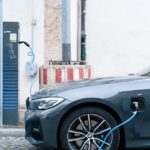 Scientists at the University of Waterloo are using parked electric vehicles to act like portable generators, helping to power overworked and old electricity grids. By studying the energy needs during busy times on Alberta’s power grid, the researchers suggest a new way to boost electricity grids using fuel cells in trucks.
Scientists at the University of Waterloo are using parked electric vehicles to act like portable generators, helping to power overworked and old electricity grids. By studying the energy needs during busy times on Alberta’s power grid, the researchers suggest a new way to boost electricity grids using fuel cells in trucks.
“Canada’s power grids need to be upgraded,” the researchers explain.
“But the price of Alberta’s power grid is much higher than other provinces. Most power is supplied by fossil fuels which results in high carbon emissions. The need to rapidly adjust generators to meet fluctuating demand is one of the reasons that the grid price is unstable and volatile. This creates the potential for clean energy storage to flatten the demand and price of electricity.”
Vehicle to grid
The team’s study builds on a technology called “vehicle-to-grid,” where special chargers send extra energy from parked electric vehicles (EVs) back to the power grid for storage. This stored electricity helps the grid during bad weather or lessens the demand during busy times.
Their idea involves paying drivers of fuel cell trucks to take a break during rush hour. While parked, they can connect to a hydrogen refueling station or pipeline and use their truck’s idle fuel cells as generators, supplying electricity to the grid.
This plan reduces traffic, cuts energy use during peak times, and provides a cleaner way to store energy. The researchers used a math model and software to figure out if hydrogen fuel cell-powered trucks could balance the grid and decrease peak prices and carbon emissions.
Unique advantages
“Hydrogen fuel cells offer advantages over other fuels like batteries which require more investment and pollute more when you dispose of them,” the researchers explain. “Our preliminary findings show that using existing fuel cells in electric vehicles of the future can decrease costs on the grid.”
This way of storing energy isn’t just for trucks. Big vehicles and trains, such as switcher locomotives that usually sit idle until they’re needed to switch train routes, could also be among the first to use this solution.
“With the increasing demand to decarbonize heavy-duty vehicles, the fuel cell electric vehicle fleet is expected to expand rapidly,” the authors conclude. “Connecting these trucks to the grid for the peak-shifting purpose may provide economic incentives for adopting hydrogen fuel cell electric vehicles and help facilitate the emergence of a large-scale hydrogen economy.”